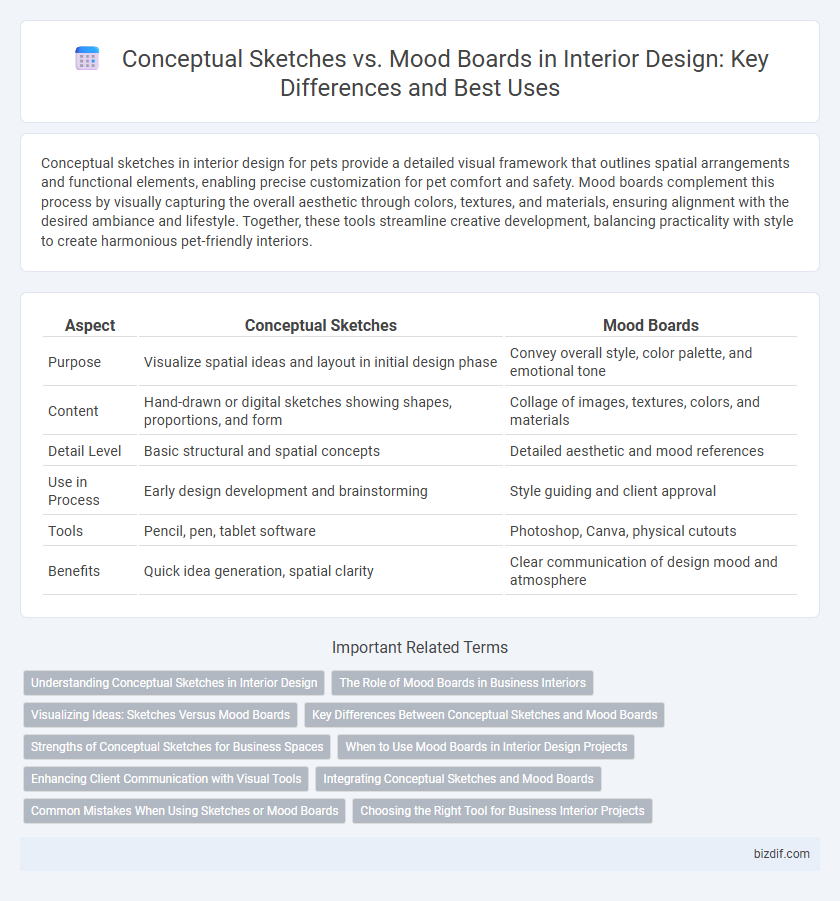Conceptual sketches in interior design for pets provide a detailed visual framework that outlines spatial arrangements and functional elements, enabling precise customization for pet comfort and safety. Mood boards complement this process by visually capturing the overall aesthetic through colors, textures, and materials, ensuring alignment with the desired ambiance and lifestyle. Together, these tools streamline creative development, balancing practicality with style to create harmonious pet-friendly interiors.
Table of Comparison
| Aspect | Conceptual Sketches | Mood Boards |
|---|---|---|
| Purpose | Visualize spatial ideas and layout in initial design phase | Convey overall style, color palette, and emotional tone |
| Content | Hand-drawn or digital sketches showing shapes, proportions, and form | Collage of images, textures, colors, and materials |
| Detail Level | Basic structural and spatial concepts | Detailed aesthetic and mood references |
| Use in Process | Early design development and brainstorming | Style guiding and client approval |
| Tools | Pencil, pen, tablet software | Photoshop, Canva, physical cutouts |
| Benefits | Quick idea generation, spatial clarity | Clear communication of design mood and atmosphere |
Understanding Conceptual Sketches in Interior Design
Conceptual sketches in interior design serve as foundational visual representations that capture the initial creative ideas and spatial arrangements for a project. They help designers explore proportions, layouts, and architectural elements quickly before refining details. Unlike mood boards that emphasize color schemes, textures, and overall aesthetic inspiration, conceptual sketches prioritize the structure and form of interior spaces, making them essential for communicating design intent to clients and collaborators.
The Role of Mood Boards in Business Interiors
Mood boards play a crucial role in business interiors by visually communicating the design concept, color schemes, textures, and materials to clients and stakeholders. Unlike conceptual sketches that focus on structural and spatial elements, mood boards offer an emotional and aesthetic representation, ensuring alignment with brand identity and company culture. Effective mood boards streamline decision-making and enhance collaboration by providing a tangible reference for designers, clients, and contractors.
Visualizing Ideas: Sketches Versus Mood Boards
Conceptual sketches provide a flexible and detailed way to visualize spatial arrangements, architectural features, and design elements with precision. Mood boards compile textures, colors, and images to evoke the overall atmosphere and emotional tone, guiding aesthetic decisions. Both tools are essential in interior design for translating abstract ideas into tangible visual representations that align client expectations with design intent.
Key Differences Between Conceptual Sketches and Mood Boards
Conceptual sketches in interior design visually communicate spatial ideas and structural elements, emphasizing form, scale, and layout, whereas mood boards compile textures, colors, and materials to convey the overall aesthetic and atmosphere of a space. Sketches prioritize precision and technical representation, making them essential for initial design development and client presentations, while mood boards inspire creativity by aggregating visual references that guide the emotional tone and style direction. The key difference lies in their function: conceptual sketches define the physical framework, while mood boards set the visual and emotional context.
Strengths of Conceptual Sketches for Business Spaces
Conceptual sketches provide precise spatial visualization and allow interior designers to experiment with layout and functionality tailored to business spaces, enhancing client communication and project accuracy. They capture the essence of design intent early, facilitating quick iterations based on client feedback and practical requirements. This hands-on approach supports innovation and ensures alignment with brand identity and operational needs in commercial environments.
When to Use Mood Boards in Interior Design Projects
Mood boards are essential during the initial phases of interior design to visually communicate style, color schemes, textures, and overall ambiance to clients and stakeholders. They help align expectations and foster collaborative decision-making by providing a tangible representation of design concepts before detailed plans are developed. Using mood boards early in the project ensures a cohesive vision and streamlines the selection of materials and furnishings.
Enhancing Client Communication with Visual Tools
Conceptual sketches provide precise spatial layouts and design ideas that help clients visualize the overall structure and flow of a space, facilitating clear communication of technical aspects. Mood boards compile colors, textures, and inspirational images to convey the emotional tone and style preferences, aligning client expectations with the designer's vision. Combining these visual tools enhances client understanding and decision-making by offering both concrete details and aesthetic context in the interior design process.
Integrating Conceptual Sketches and Mood Boards
Integrating conceptual sketches and mood boards enhances the interior design process by providing a visual framework that combines structural ideas with color schemes, textures, and ambiance. Conceptual sketches outline spatial arrangements and design elements, while mood boards convey the emotional tone and material palettes, creating a cohesive narrative for client presentations. This synergy ensures clear communication of design intent and streamlines decision-making from initial concepts to final execution.
Common Mistakes When Using Sketches or Mood Boards
Common mistakes when using conceptual sketches or mood boards in interior design include relying too heavily on sketches without considering practical constraints such as space dimensions and material availability. Overloading mood boards with inconsistent styles or colors can create confusion and dilute the design vision. Ignoring client feedback during the sketch or mood board phase often leads to revisions and project delays.
Choosing the Right Tool for Business Interior Projects
Conceptual sketches provide precise spatial layouts and detailed design elements crucial for client presentations and contractor guidance in business interior projects. Mood boards convey the overall aesthetic, color schemes, and material textures, helping to align project vision with client expectations early in the design process. Selecting the right tool depends on the project phase: use conceptual sketches for technical accuracy and mood boards for creative direction and client engagement.
conceptual sketches vs mood boards Infographic

 bizdif.com
bizdif.com